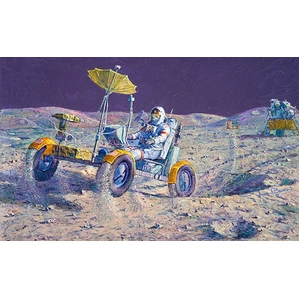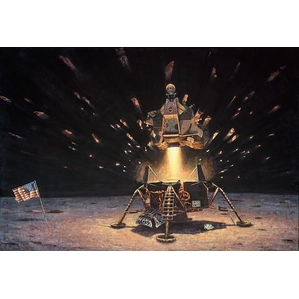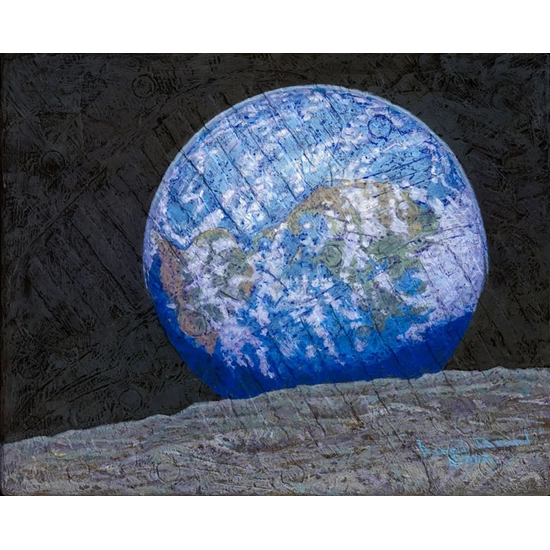Alan Bean Way Way Up High Over Pad 39A Giclee On Canvas
Status: Out Of Stock | Condition: New | Edition:Limited Edition Giclee On Canvas | Edition Size: Limited Edition: 95pcs | Dim:20 X 16 | Alan Bean| Item #: GWWAYWAY
Price: $ 0.00 USD..
No availability at this time. Be First to be notified once we have Alan Bean - Way Way Up High Over Pad 39A in-stock
Countries We Ship To:
Alan Bean, a former Apollo 12 astronaut, transformed his firsthand experience of space exploration into stunning fine art paintings. As the only artist to have walked on the Moon, his work captures the textured surface of the lunar landscape, often embedding real moon dust and mission patches into his canvases. His impressionistic space paintings bring the Apollo era to life, showcasing astronaut moonwalks, celestial landscapes, and cosmic exploration from a perspective no other artist can provide. His limited edition space prints and original paintings remain highly sought after by collectors of space history art, making Alan Bean a pioneer in astronaut-inspired fine art.
Way Way Up High Over Pad 39A - GWWAYWAY
NOTES: Well, here we are, seeing our first Earthrise ever! It is hard to believe Pete Conrad, Dick Gordon and I are 235,189 miles from home. We had lifted off from launch complex 39, Pad A, Cape Kennedy, Florida in the middle of a violent thunderstorm, just three and one half days ago and there are at least two very excellent reasons why it does not seem possible we have come this far, this fast. The first excellent reason is that we were traveling at speeds that are difficult for most humans, including us, to really grasp. For example, after a brief eleven-minute rocket ride, we were in Earth orbit traveling at 17,431 miles per hour. That is about 290 times faster than the 60 miles per hour speed limit we drive our cars here on Earth. Pete, Dick and I had been navy test pilots and flew high performance aircraft at high mach numbers from time to time, but mostly we flew around at about 500 miles per hour or so. Now, that is nothing to complain about, yet it is only one thirty-fifth of our Earth orbital speed. But to fly to the Moon, we had to start up our launch rocket"s third stage again to add significant velocity. To be precise, we had to get going 6,719 miles per hour faster. This initial velocity, some 24,150 miles per hour, would allow us to coast to a point close enough to the Moon so the Moon"s gravity would become dominant and we would begin to fall towards the Moon rather than back to Earth. The second excellent reason is that there were no sign posts along the way. As we sped along, we did not zip past any cities, towns, clouds, other spaceships, or anything else, for that matter. Except for the first few hours after leaving Earth orbit, the Earth did not seem to move away or get smaller, and the Moon did not seem to move toward us or get larger. If we waited an hour or so and looked out again, the Earth would look smaller . . . maybe, and the Moon would look larger . . . maybe. What a view! To think everyone I ever knew, saw on television or at the super bowl, was down there on the skin of that beautiful, colorful sphere. It does not seem possible. There is just not enough room and folks on the bottom will surely fall off. I find it curious that I never heard any astronaut say that he wanted to go to the Moon so he would be able to look back and see the Earth. We all wanted to see what the Moon looked like close up. Yet, for most of us, the most memorable sight was not of the Moon, but of our beautiful blue and white home, moving majestically around the sun, all alone in infinite black space..
Way Way Up High Over Pad 39A Giclee On Canvas by Alan Bean is signed by the artist and comes with a certificate of authenticity.
image Copyright © 2025 by Alan Bean

Gift Card Purchase
E-Gift Cards from The Collection Shop are the perfect way to gift art enthusiasts. Click below for more details!
Alan Bean bio
Captain Alan Bean was the lunar module pilot on Apollo 12, the fourth man to walk on the moon and commander of Skylab 2. "I am fortunate enough to have seen sights no other artist ever has," Bean says.
"I want my paintings to communicate an emotional experience in ways that photography cannot."
Captain Bean creates his original works of art using a unique technique allowing the viewer to actually sense vestiges of the 20th century s most dramatic accomplishments. Pressed into the canvas surfaces are Captain Bean s authentic lunar boot "moonprints," impressions from a core tube-bit used to collect soil samples and marks from a hammer used to drive the staff of the American flag into the moon s surface. Moon dust, trapped on the patches on the outside of his suit, makes its way onto each original as well.
Each print and canvas is an historical record of the lunar experience, as each is signed by moonwalker Captain Alan Bean, with most countersigned by other moonwalkers and astronauts.This may be your only chance to own such a visionary and historic celebration of man s greatest achievement. NASA was sometimes asked "Why not send an artist to the moon?" It turns out they did.
Alan Bean—Apollo XII astronaut, commander of Skylab II and artist—was born in 1932 in Wheeler, Texas. In 1950 he was selected for an NROTC scholarship at the University of Texas at Austin. In 1955, he was commissioned an ensign in the United States Navy.
Holder of eleven world records in space and astronautics, as well as numerous national and international honors, Alan Bean has had a most distinguished peacetime career. His awards include two NASA Distinguished Service Medals, the Yuri Gagarin Gold Medal and the Robert J. Collier Trophy. As part of the Apollo XII crew, he became the fourth of only twelve men ever to walk on the Moon. As the spacecraft commander of Skylab Mission II, he set a world record: 24,400,000 miles traveled during the 59-day flight. He has also launched himself successfully into a new career as an artist.
When he wasn t flying, Bean always enjoyed painting as a hobby. Attending night classes at St. Mary s College in Maryland in 1962, Alan experimented with landscapes. During training and between missions as a test pilot and astronaut, he continued private art lessons. On space voyages, his artist s eye and talent enabled him to document impressions of the Moon and space to be preserved later on canvas. His art reflects the attention to detail of the aeronautical engineer, the respect for the unknown of the astronaut and the unabashed appreciation of a skilled painter.
The space program has seen unprecedented achievements and Bean realized that most of those who participated actively in this adventure would be gone in forty years. He knew that if any credible artistic impressions were to remain for future generations, he must paint them now. "My decision to resign from NASA in 1981 was based on the fact that I am fortunate enough to have seen sights no other artist ever has," Bean said, "and I hope to communicate these experiences through art."
Bean s book Apollo: An Eyewitness Account which chronicles his first-person experience as an Apollo astronaut in words and paintings was received with critical and popular acclaim upon its publication in 1998.

Alan Bean Lunar Grand Prix Canvas - AB00061
..Layaway with 3 pymts of $0.00

Alan Bean The Eagle is Headed Home Canvas - AB00049
..Layaway with 3 pymts of $0.00








